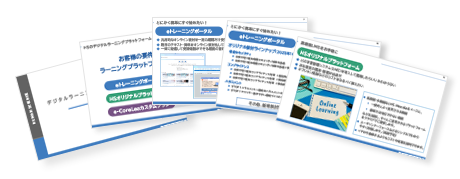2017.11.01
Basic e-Learning for Corporate Education Part 3 (e-Learning and Group Training)
In the first installment of this series, "Introduction to e-Learning in Corporate Education", we touched upon the broad definition of e-Learning as various forms of learning that utilize IT. It is common to use a Learning Management System (LMS) for learning management.
In this installment, we will introduce the advantages and disadvantages of e-Learning compared to group training.

1. Various Names for e-Learning
Let's deviate from the main topic for a moment, but the term used to refer to e-learning may differ depending on the company or organization. How is it expressed in your organization? There may be other terms besides the ones listed below.
| ・e-Learning (e-learning) ・Web training, web education ・Web training ・Web learning ・Video, video materials (including non-video materials) |
・WBT (Web Based Training) ・CBT (Computer Based Training) ・Online Learning ・eL (reading only) ・eL (writing only) and others |
It seems that many companies have been using WBT and CBT since the early 2000s.
2. eLearning vs. Group Training
There are differences between e-learning and group training that need to be considered, taking into account the situation and educational content, and choosing an educational method that utilizes strengths and considers weaknesses.
For example, e-learning has a high value when there are learners nationwide or when working hours vary, but it is also known that there are problems such as decreased motivation of learners (lower learning effectiveness). On the other hand, group training has the characteristics of being greatly affected by the skills and compatibility of the instructor, and the cost tends to increase as the number increases.
| Features of e-learning | Features of Group Training | |
|---|---|---|
| Time | ◎ No travel time required ◎ Available for learning anytime ◎ Can progress at your own pace ◎ Speedy information delivery also possible |
△ Participant and instructor must travel △ Only available during designated time |
| Location | ◎ Connect to the network anywhere | △ Venue Required |
| Cost | ◎ Relatively inexpensive (system and content fees) | △ Relatively expensive (venue fee, transportation fee, etc.) |
| Example | △ While we can provide the same quality and content, the content tends to be flat in order to appeal to a larger audience. △ Communication is difficult as it is one-way. |
◎ It is also possible to adjust the content based on the participants' reactions. ◎ Participants can ask questions until they fully understand. |
| Instructor | ○ Not required or video appearance. High teaching ability (facilitation, etc.) is not required if you have knowledge. | △ High-quality training requires not only experience and knowledge, but also high teaching ability. |
| Attendee | △ Strong awareness of oneself (or someone invisible) and tendency for motivation to decrease | ◎ Demonstrates high motivation and effectiveness depending on the understanding of the boss and the instructor. |
| Operations Manager | ◎ Can manage learning results △ IT knowledge required |
△ Schedule adjustments and handling of absentees are necessary. |
| Appropriate | △ Suitable for acquiring knowledge, not suitable for practical skills | △ Suitable for practical skills and advanced learning, not suitable for acquiring knowledge |
※ Evaluation results may vary depending on the specific conditions and services used.
3. Reasons for Introducing e-Learning
Many companies choose to implement e-learning for a variety of reasons (including those listed below), but the reasons for a company to decide to introduce e-learning are often attributed to the following factors.
- Cost Reduction (Instructor, Venue Fee, Transportation Fee)
- Remote Education (Dispatching instructors to nationwide and overseas is not realistic)
- Standardization of Education (Same content, anytime, anywhere)
- Learning management is possible
- Reducing the burden (it is difficult for the target audience to gather at the same time and place) etc.
4. Service to complement each other's shortcomings

e-Learning and group training, various mechanisms and technologies are also being used to complement the advantages and disadvantages of each.
- ・Cloud LMS:
- Reduce operational burden and costs, even if IT knowledge and support are not required
- ・Blending Training/Inverted Learning:
- Combining the strengths of e-learning and group training
- ・Video・VR・Microlearning and others:
- Knowledge retention, technical acquisition, and behavioral transformation are possible.
- ・Social Learning:
- Communication between participants and instructors (such as SNS)
- ・Adaptive Personalized Learning:
- Providing content tailored to individual characteristics and situations
- ・Microlearning:
- A system for developing human resources that utilizes not only shortness, but also the characteristic of being short.
When introducing e-learning for the first time, it is necessary to consider the introduction of a convenient cloud LMS and the blending of existing group training, but it is often hasty to introduce other systems and technologies.
It is a good idea to carefully consider the cost and necessity before considering them.
5. Failed e-Learning
However, due to reasons such as not being able to fully utilize strengths or cover weaknesses, it is difficult to say that many e-learning programs are being fully utilized.
We plan to introduce the characteristics of successful and unsuccessful e-learning programs in future blog topics.
Past Articles: "Fundamentals of e-Learning in Corporate Education" Series
① Introduction: e-Learning is different from school education
② Theory: Instructional Design (ID) and more

Author:
Keigo Ryuno
Education Solutions Department, Consulting Unit
・Experience as a training instructor and web designer
・Engaged in education design and e-learning development
・Learning Designer (eLC certified)
・ATD International Professional Member
Introducing case studies of companies that have adopted our servicese-Learning Service
Case Study Collection
From support for introducing e-learning to creating materials, Human Science offers a variety of services related to e-learning.
In this case study collection, you can see examples of how 5 companies have used our services. Please take this opportunity to download it.

[Introduction Company]
- FUJIFILM Service Creative Corp.
- NIPPON DENSETSU KOGYO CO.,LTD.
- Sanken Electric Co., Ltd.
- The Open University of Japan
- Okinawa Institute of Science & Technology Graduate University
5Introducing Case Studies
Latest Blog
- 2024.04.02
- English Learning Using Moodle and ChatGPT












